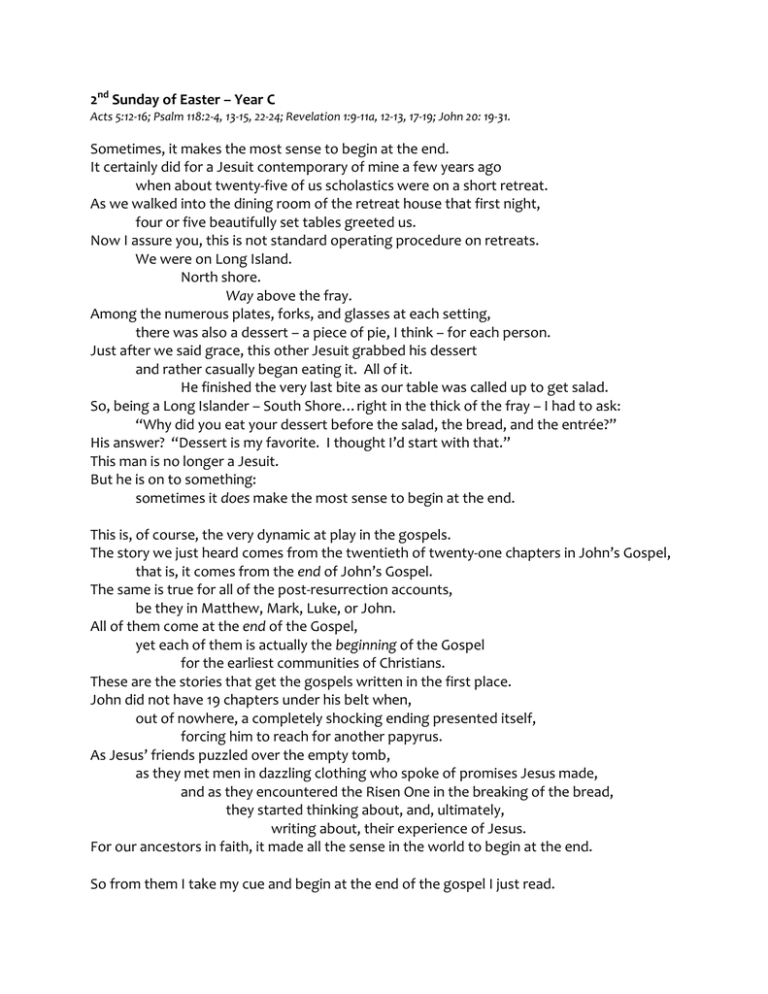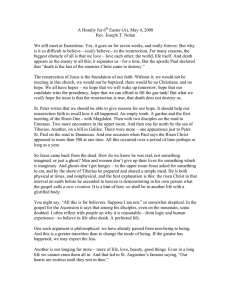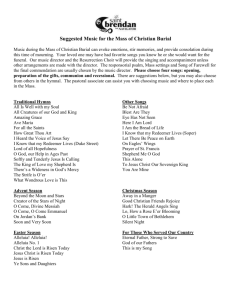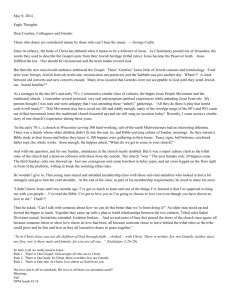2 Sunday of Easter – Year C
advertisement

2nd Sunday of Easter – Year C Acts 5:12-16; Psalm 118:2-4, 13-15, 22-24; Revelation 1:9-11a, 12-13, 17-19; John 20: 19-31. Sometimes, it makes the most sense to begin at the end. It certainly did for a Jesuit contemporary of mine a few years ago when about twenty-five of us scholastics were on a short retreat. As we walked into the dining room of the retreat house that first night, four or five beautifully set tables greeted us. Now I assure you, this is not standard operating procedure on retreats. We were on Long Island. North shore. Way above the fray. Among the numerous plates, forks, and glasses at each setting, there was also a dessert – a piece of pie, I think – for each person. Just after we said grace, this other Jesuit grabbed his dessert and rather casually began eating it. All of it. He finished the very last bite as our table was called up to get salad. So, being a Long Islander – South Shore…right in the thick of the fray – I had to ask: “Why did you eat your dessert before the salad, the bread, and the entrée?” His answer? “Dessert is my favorite. I thought I’d start with that.” This man is no longer a Jesuit. But he is on to something: sometimes it does make the most sense to begin at the end. This is, of course, the very dynamic at play in the gospels. The story we just heard comes from the twentieth of twenty-one chapters in John’s Gospel, that is, it comes from the end of John’s Gospel. The same is true for all of the post-resurrection accounts, be they in Matthew, Mark, Luke, or John. All of them come at the end of the Gospel, yet each of them is actually the beginning of the Gospel for the earliest communities of Christians. These are the stories that get the gospels written in the first place. John did not have 19 chapters under his belt when, out of nowhere, a completely shocking ending presented itself, forcing him to reach for another papyrus. As Jesus’ friends puzzled over the empty tomb, as they met men in dazzling clothing who spoke of promises Jesus made, and as they encountered the Risen One in the breaking of the bread, they started thinking about, and, ultimately, writing about, their experience of Jesus. For our ancestors in faith, it made all the sense in the world to begin at the end. So from them I take my cue and begin at the end of the gospel I just read. Recall the final words: “Now Jesus did many other signs in the presence of his disciples that are not written in this book. But these are written that you may come to believe that Jesus is the Christ, the Son of God, and that through this belief you may have life in his name” (Jn. 20:30-31). John gives us an important key here to understanding anything we read in the gospels, and I would say it is especially important for the post-resurrection accounts. These stories tell us something about the Risen One in order to stir up belief in him, and consequently, to cultivate deeper life in ourselves. The message of tonight’s famous story, the same story we hear every year on this Sunday, is simple enough: the Risen One will give us whatever we need to believe. Doubting Thomas? Red herring. Now don’t get me wrong: I am not saying that Thomas is insignificant or that his incredulousness has nothing to teach us. But this is the Second Sunday of Easter, Divine Mercy Sunday; not Pile on St. Thomas Sunday. If we put all of our focus on Thomas, if we make him the center of this story, then, at best, we walk away thinking that we should have deeper faith – a fine message, to be sure, but one that reveals little about the Risen One. At worst, concentrating on Thomas alone might leave us patting ourselves on the back because, unlike him, we did not have the luxury of being in the actual physical company of Jesus of Nazareth. Blessed are we who have not seen, but still believe! Nevertheless, Thomas, who famously asked Jesus, “How can we know the way?” (Jn. 14:5), himself becomes our way to understand something about the Resurrected Christ. Imagine being in Thomas’s position: someone you love has just died, and you’re not quite sure what this means for your life; the way forward is not clear; you are sad, angry, confused, and lots of other things that, well, they just don’t have words to describe. You take a walk by yourself to clear your head, perhaps to wake up from what you hope has been just an awful dream. When you return to your friends who, hours before, felt exactly as you did, something has changed. They are smiling; talking hurriedly; telling you that he was here; that you missed him. You ask, “If he can pass through the doors of this room, 2 if he can pass through the doors of death, why did he come when I was gone? Why did Jesus, whom I loved, who loved me, come here when I was looking for him out there?” You can’t believe he would do that. You won’t believe. But you want to believe. What do you need to believe? “Unless I see the mark of the nails in his hands and put my finger into the nailmarks and put my hand into his side, I will not believe” (Jn. 20:25). This will not do for the Risen One, who is in the business of strengthening belief, of breathing the warmth of his spirit upon those whose hearts have grown cold from sadness, anger, confusion, and lots of other things that, well, they just don’t have words to describe And so, the one who came back from the dead, comes back to the room where the disciples were gathered, locked doors and all. He comes back to give Thomas what he needs to believe. As it turns out, Thomas needs far less than he thought he did. When Christ says, “Put your finger here and see my hands, and bring your hand and put it into my side, (Jn. 20:27), Thomas does not take him up on his offer. What Thomas needed to believe in the Risen One was not a hands-on experience, it was the presence of the one he loved, the one he missed, the one he sought when he took that lonely walk on the night of the first Easter. Christ gave him exactly what he needed. What do I need to believe in Christ? What do I need to believe that the empty tomb symbolizes the radical presence of Christ in my life and in my relationships? Perhaps Thomas can show us the way. He points us to a path that, yes, has doubts – every path worth walking has doubts – but more importantly, his path has the boldness, the audacity, to believe in spite of the doubt. Thomas’s path has the guts to name what is going to be necessary for belief. His path trusts that the Risen One will give us whatever we need to believe. May Thomas’s way, his path, be ours as well. 3








